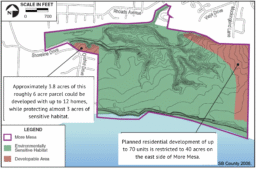
More Mesa faces two substantial threats of development that could seriously harm ecological, scenic, and recreational values. The first is under existing approved plans. County plans adopted in 1993 currently restrict building to 70 large homes on the northeast 40 acres of the 265 acres privately owned. The remaining 225 acres are designated as Environmentally Sensitive Habitat (ESH) as part of the County’s Local Coastal Plan, which inhibits development in these areas. Even under current regulations, development of 70 new large homes on 40 acres could destroy wetland and oak woodland habitats, harm raptor roosting and foraging areas, disrupt the major public coastal access trail, and permanently scar the mesa’s scenic vistas. Such development would also impact adjacent homes in Hope Ranch.
The second, and perhaps even greater, threat is the state mandates requiring local governments to approve extensive new high-density housing. As part of the 2029 Housing Element, the County will be required by the state to plan for additional high-density housing in the Eastern Goleta Valley, sometimes called “Noleta.” For the 2025 Housing Element, the County was already forced to overturn long-standing policies protecting Goleta Valley farmland in order to allow approximately 4,000 unitsof high-density housing. If the state’s 2029 Regional Housing Needs Allocation (RHNA) is similar to that from 2025, it seems clear that More Mesa will again be under threat. Since it is the largest remaining undeveloped area in the Eastern Goleta Valley, rezoning the 40 acres where development of up to 70 homes is currently allowed could lead to high-density development of 20 or more units per acre. This could result in 800 or more units built adjacent to sensitive habitat and the Hope Ranch neighborhood.
Additional concerns are ongoing state efforts to streamline housing development and weaken environmental protections. This is clearly illustrated by recent amendments to the California Environmental Quality Act (CEQA), which significantly weakened this foundational environmental law. If similar efforts are made to reduce protections under the State Coastal Act, large areas of More Mesa currently shielded by policy could become vulnerable to large-scale development. That would severely impact important wildlife habitat, as well as scenic and recreational values. Although the More Mesa Preservation Coalition (MMPC) is working to track these legislative changes, the CEQA amendments were pushed through with minimal public input as part of the Governor’s budget. This is a troubling trend. While no new development is currently pending and we do not know the intentions of the current owner, these legislative changes and the precedent set by the 2025 Housing Element should be ringing alarm bells throughout the community.
MMPC has successfully opposed past development proposals, but it will be far more difficult to stop a project that is backed by state mandates and revised laws. Previous owners of the Mesa’s 265 acres have also resisted habitat protections and expressed interest in building far more than currently allowed. At various times, ideas such as a hotel, golf course, horse boarding facility, and even a mall have been proposed. All would create significant environmental harm.
In 2007, the owner of More Mesa requested an Updated Biological Resources Study to assess possibilities for rezoning to allow higher-density development. While this study was never finalized, the draft may be found in the Biological Resource Studies section of this website. That draft largely confirmed and supported the ESH designations that protect most of the mesa. Still, the looming 2029 Housing Element mandates and any potential weakening of the State Coastal Act could put More Mesa at serious risk.
More Mesa was sold to a Saudi developer in late 2012 and, as of 2025, was listed for sale for a reported $65 million.